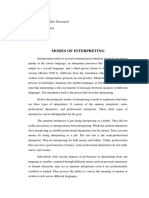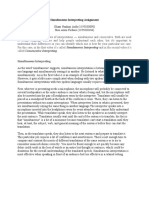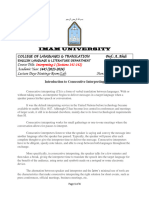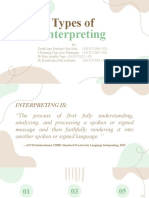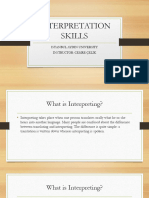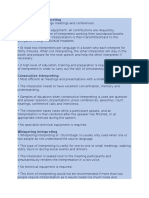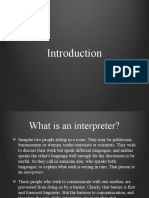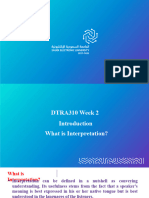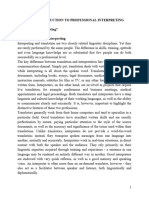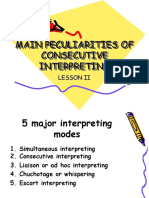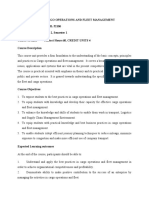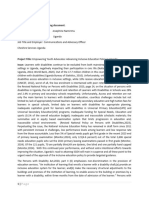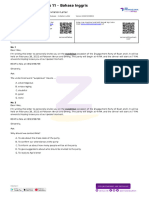Different Types Of Interpretation
Interpretation is the art of transforming a message from one language to another, either
through speaking or signing. Unlike translation, which involves written communication,
interpretation is done verbally or through sign language.
Simultaneous interpretation
In this mode of interpretation, the interpreter delivers the message in the target language
in real-time, at the same time as the speaker is still talking.
In traditional simultaneous interpretation setups, interpreters work from an interpreting
booth where they get a view of the room, wear a headset and interpret into a microphone.
They work in pairs and interpret for intervals of 20-30 minutes.
A classic example of a simultaneous interpreter in action occurs at an international
conference. The speaker takes the stage and speaks in their native tongue. In booths
around the room, interpreters translate the speaker’s words so the audience can listen in
different languages.
Consecutive interpretation
This type of interpretation requires the interpreter to wait for the speaker to finish their
speech or statement before proceeding to deliver that same message in the target
language. Since the interpreter has to wait for the speaker to finish talking, they usually
take notes to remember what’s being said and later use them to deliver the interpretation.
Some scenarios where consecutive interpretation is used are official statements and
diplomatic visits.
Interpreters taking on a consecutive interpretation project must have a strong memory and
note-taking skills to keep information organized over minutes-long stretches of speech.
Bilateral interpretation
This is the type of consecutive interpretation done when two parties who don’t speak the
same language meet. In it, the interpreter relays the message after the speaker has paused
or finished speaking in each language in turns so that the conversation between the
parties can happen. Situations, where bilateral interpretation is used, include doctor
appointments, business meetings, negotiations, court hearings, or police interviews.
Sign language interpretation
Sign language interpretation is a vital tool that translates spoken or written language into
visual communication through the use of gestures and facial expressions. This enables
�individuals who are deaf or hard of hearing to participate fully in various settings,
including education, law, medicine, and social interactions.
Whispered interpretation or chuchotage
This is the case when the interpreter whispers the message in the target language while
the speaker is talking, to a small audience of maximum of four people. For this, the
interpreter needs to be located close to the audience and this is typically done in small
meetings and settings.
In-person interpretation
In-person interpretation takes place when the interpreter is physically present at the event.
For simultaneous interpretation, the interpreters work in pairs from interpreting booths
equipped with microphones, headsets, and an interpreting console that allows them to
choose the language they listen to, mute themselves, and more. Attendees can listen to
the interpretation using traditional radio receivers, or specialized mobile apps. This mode
is typically used for large conferences, governmental meetings, or any other event where
the duration and flow of the meeting are crucial.
Over-the-phone interpretation (OPI interpretation)
This mode of interpretation allows two people who don’t speak the same language to
connect using an interpreter over the phone. This kind of interpreting is usually done
consecutively so, the interpreter lets one party speak, then relays the message in the other
language.
Remote interpretation
we can distinguish between Video Remote interpretation and Remote Simultaneous
Interpretation.
Video Remote interpretation (VRI):
Typically done using a web camera or videophone system to provide sign language
or spoken language interpretation services between two parties who can’t otherwise
communicate.
Remote simultaneous interpretation (RSI):
In this interpreting mode, interpreters can work from anywhere in the world if they have a
laptop or desktop and a stable internet connection.
Escort/Travel Interpreting
�These interpreters travel with individuals or small groups wherever they go on a business
or diplomatic trip, providing interpretive services in a range of settings. In addition to
business meetings and presentations, these interpreters can also assist clients at
restaurants, retail shops, or any other location these individuals might travel.
On-Demand Phone Interpreting
On-Demand Phone Interpreting is for individuals or organizations that need to
communicate across language barriers immediately. This form of interpreting is
performed when a party calls a service, selects the required language pair and is
connected to an interpreter. The interpreter then comes on the line and interprets the
conversation.
On-Demand Phone Interpreting is often used by customer service call centers, and by
companies, organizations, pharmacies, medical and legal institutions
Simultaneous relay interpretation
Simultaneous relay interpretation works well at conferences with multiple target
languages or anytime you can’t find an interpreter for a particular language pairing.
Imagine a conference delivered in German with delegates attending who speak English,
Spanish, Mandarin, and Portuguese. With simultaneous relay interpretation, the first
interpreter would translate from German to English. Then, the other interpreters translate
from English to Spanish, Mandarin, and Portuguese. From the delegates’ perspective, it
would seem like a standard simultaneous interpretation.
Consecutive Relay Interpretation
A meeting where attendees speak various minority languages presents the perfect
opportunity for consecutive relay interpretation. The interpreters would translate the
words of each participant into one language, such as English. Then, during pauses, the
interpreters would relay the message to individual listeners after translating it from
English to the relevant minority tongues.
Liaison Interpretation
A liaison interpreter acts as a translator for two individuals as they speak in turns,
enabling them to converse fluidly. Liaison interpretation represents a form of consecutive
interpretation.
Picture a high-profile businessperson visiting the company of a fellow entrepreneur in a
foreign country. The liaison interpreter would accompany the businessperson for the
entire visit, following them around the premises and translating as required.






